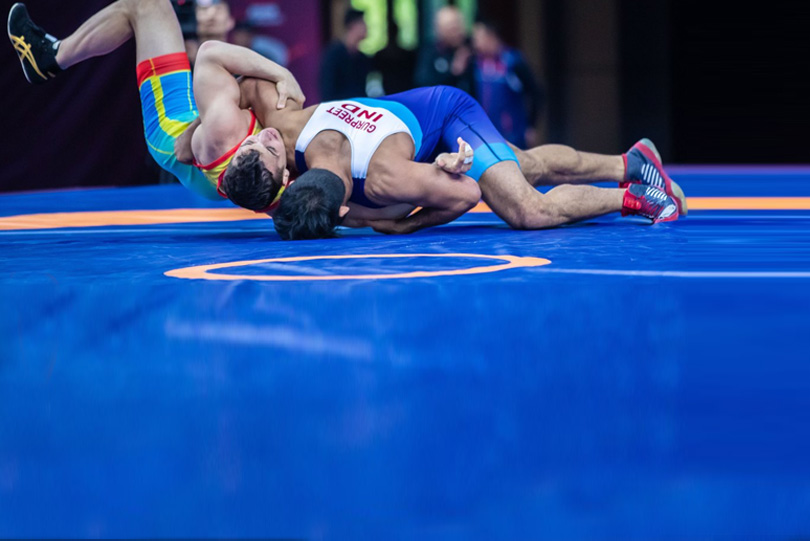Greco-Roman wrestling 'hoping' for a new lease of life in India

India has only won a solitary medal at World Championship in Greco-Roman
|(Twitter)
A long, nervous walk into the arena; he wipes his face with his sweaty palms, looks through a section of the crowd as if trying to make a statement, with 'hope' in his heart to win a medal in wrestling for his nation at the Olympics.
This was Sushil Kumar on the cusp of making history at the Beijing Olympics, holding on to a 'hope'; the very 'hope' that would have ignited a fire in a young wrestler KD Jadhav to win a medal for India at the Helsinki Olympics in 1952.
Now, despite moving in the right direction in freestyle, India hasn't quite been able to do justice to Greco-Roman form, with 'hope' being the only thread to which the fortunes of the latter seem to be tied with. The wrestling style, mighty popular mainly in Eastern Europe, is starting to find its feet in some Asian countries like Iran and Japan, but unfortunately, India seems to be a distant last in that group. Not that the country doesn't produce any Greco-Roman wrestlers, but there is a visible distinction in quality and quantity.
A form which alone has six medals at the Olympics and has been part of the Games since the first edition in 1896, there's very little done in the country to lay a claim on those additional medals. While it is understandable, that it takes a big-ticket win to bring a paradigm shift in sport in India, it hasn't quite happened with Greco-Roman.
The success that badminton witnessed in India after Pullella Gopichand's All England triumph in 2001, is second to none. The country produced champions in dozens, with Saina Nehwal and PV Sindhu emerging as a class apart. Sushil's bronze in 2008 can be spoken of in the same light, and so can Mary Kom's bronze in 2012. But Sandeep Tulsi Yadav's bronze medal in Greco-Roman at the World Championship in 2013 hasn't quite managed to lift the sport from the perennial state of obscurity. The form of wrestling where the grapplers are prohibited from using their legs for attack or defense, and mainly rely on throws and lifts to score, has a handful of takers in the country.
In what should have been a stepping stone for greater success, India has no medals to show in World Championship after Yadav's bronze. The tally at the Olympics still remains naught, with no Greco-Roman wrestler qualifying for the Games this time around. With the situation appearing baffling, it comes as no surprise to former Greco-Roman national coach Kuldeep Singh, who was at the helm of affairs when Yadav won in 2013 at Budapest.
Aware of ground reality, an articulate Singh points out that the wrestlers or even the federation are hardly to blame. It is just a cultural block of the Akhara puritans, that does not accept anything western. "The poor returns of Greco-Roman in the country can be attributed to the culture inclined towards freestyle wrestling. We just don't have a sound culture of Greco-Roman wrestling in the country," Singh told SportsCafe.
It is this culture that to date Greco-Roman wrestlers are selected from the freestyle lot only. There are hardly any schools, Akharas, or academies that train young grapplers in Greco-Roman right from the start, as it should be.
"To cut the long story short, wrestlers don't start in Greco-Roman, but only in freestyle. If there is a push from the grassroots, where these kids take part in a lot of competitions; if Greco-Roman is paid as much importance as freestyle, then only can the discipline come up. So in India, almost all the Greco-Roman wrestlers have a solid background in freestyle wrestling, say for about 18-20 years, and that is when they are picked for the other style. So you can understand why we aren't a force to reckon with in this style.
"Back in the '80s and 90's we never used to have dedicated wrestlers in this discipline, in fact, the second-best would represent the country in Greco-Roman. It is only in the last 15 years that we have dedicated tournaments now, and the scene has changed a bit, but at snail's pace."
At least for now, small changes have started coming up, which could lead to a more promising future. Also, some of the wrestlers from the current crop -- Gurpreet Singh, Harpreet Singh and Sunil -- have it in them to make their presence felt at the world stages. "Greco-roman has started in some places at the school and university level, but again results will take some time to come from there. But we could do with a better system in place. The only major difference from a few years earlier to now is that we have regular participation in Greco-Roman.
"Some of our boys are good enough to take on wrestlers from Iran, Kyrgyzstan and Kazakhstan, but to be at Russia's level, we might have to wait for some time. But I am hopeful that results will come sooner rather than later. I think it is a no-brainer that, as we invested in freestyle, same model should be adopted for Greco-Roman, and the results will follow," concluded Singh.
Clinging on to that 'hope', India will truly become an overall giant of wrestling, when nothing short of equal focus on Akhara wrestling, freestyle, and Greco-Roman is paid. All three would have to co-exist with each feeding on the other's success. But for that to happen India would have to accept what is not theirs.
